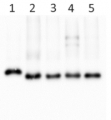1

Anti-PetD | Cytochrome b6-f complex subunit 4
AS22 4711 | Clonality: Polyclonal | Host: Rabbit | Reactivity: Arabidopsis thaliana, Synechocystis sp. , Synechococcus sp., Cyanobacterium aponinum, Chlorogloeopsis sp.
- Product Info
-
Immunogen: KLH-conjugated peptide derived from Arabidopsis thaliana PetD protein sequence, UniProt: P56774, TAIR: AtCg00730 Host: Rabbit Clonality: Polyclonal Purity: Antigen affinity purified serum, in PBS pH 7.4 Format: Lyophilized Quantity: 50 µg Reconstitution: For reconstitution, add 50 µl, of sterile or deionized water. Storage: Store lyophilized/reconstituted at -20°C; once reconstituted make aliquots to avoid repeated freeze-thaw cycles. Please, remember to spin tubes briefly prior to opening them to avoid any losses that might occur from lyophilized material adhering to the cap or sides of the tubes. Tested applications: Western blot (WB) Recommended dilution: 1 : 1000 (WB) Expected | apparent MW: 17.4 kDa - Reactivity
-
Confirmed reactivity: Arabidopsis thaliana, Synechocystis sp. , Synechococcus sp., Cyanobacterium aponinum, Chlorogloeopsis sp.
Predicted reactivity: Gossypium sp. , Helianthus annuus, Hordeum vulgaris Gossypium sp., Zea mays
Species of your interest not listed? Contact usNot reactive in: No confirmed exceptions from predicted reactivity are currently known - Application Examples
-

Samples:
LD: PAGE ruler Prestained (ThermoFisher)
1 - Synechocystis sp.
2. Synechococcus sp.
3. Cyanobacterium sp.
4. Chlorogloeopsis sp.
5 µg/well of total proteins were loaded/well. Proteins were extracted freshly from 10 ml of exponentially growing cyanobacterial cultures (0.5-1 OD730). Lysis was performed via beadbeating (0.1 mm glass beads) 3 times (20s 6000 rpm and 2 min on ice) in precooled 100 mM Tris-HCl (pH 7.6) 10% glycerol and cOmpleteTM, EDTA-free protease Inhibitor Cocktail (Merck). Then extracts were centrifuged at 17.000g for 25 min at 4°C to retrieve cytosolic fraction. Protein concentration was quantified using BCA assay and a BSA standard. Samples were denatured in 50 mM Tris-HCl (pH 6.8), 100 mM DTT, 2% SDS, 5 mM EDTA and 10% glycerol (final concentrations) + bromophenol blue stain. Denatured for 10 min at 95°C and separated in a 8-16% gradient SDS-PAGE using MOPS buffer. Samples were blotted in a Nitrocellulose membrane in a wet transfer system during 1.5h at constant current of 150 mA. Membrane was blocked overnight in 5% milk PBS-Tween buffer in agitation. Then, incubation of primary antibody (1:1000) performed during 1h at RT in 2.5% milk PBS-T. The antibody solution was decanted, and the blot was rinsed briefly twice, then washed 3 times for 15 min in PBS-T at RT with agitation. Blot was incubated in Agrisera matching secondary antibody (anti-rabbit IgG horse radish peroxidase conjugated, AS09 602) diluted to 1:25 000 for 1h/RT with agitation in 2.5% milk PBS-T. The blot was washed as above and adding a last step with only PSB (no Tween added). And developed for 5 min with Agrisera AgriseraECLSuperBright with a LI-COR Odissey Fx Imager. Exposure time was 300 seconds.

Samples:
1 - 10 ug of 4 days old of wild-type Arabidopsis thaliana seedlings extract
2 - 5 ug of 4 days old of wild-type Arabidopsis thaliana seedlings extract
3- 10 ug of 4 days old of gun5-1 mutant seedlings extractExact buffer components were: (50 mM Tris–HCl pH 7.5, 10% glycerol, 150 mM NaCl, 10 mM MgCl2, 5 mM EDTA, 5 mM DTT, 0.5% (v/v) Triton X-100, and 1 × protease inhibitors) and denatured with 4X SDS sample loading buffer (200 mM Tris-Cl (pH 6.8). 8% SDS (sodium dodecyl sulfate). 0.4% Bromophenol blue. 40% glycerol) at 95 °C 10 min. Samples were separated in the RT on 15 % SDS-PAGE and blotted for 0.5 h to PVDF (pore size of 0.2 um), using: semi-dry at room temperature. Blot was blocked with 5 % milk for: 1h/RT with agitation. Blot was incubated in the primary antibody at a dilution of 1: 2 000 at 4°C with agitation overnight. The antibody solution was decanted, and the blot was rinsed briefly twice, then washed once for 15 min and 3 times for 5 min in TBS-T at RT with agitation. Blot was incubated in matching secondary antibody (anti-rabbit IgG horse radish peroxidase conjugated, AS09 602 Agrisera) diluted to 1: 50 000 for 2 h/RT with agitation. The blot was washed as above and developed with a following chemiluminescent detection reagent: AS16 ECL-N-10 AgriseraBright (mid picogram). Exposure time was 1 minute. Ther high cross reactivity above 50 kDa can be optimized by increasing blocking to 10 % nonfat milk and incubation of a primary antibody at 1: 2000 1h/RT.
Courtesy of Dr. Duorong Xu, LMU München, Germany
- Background
-
Background: PetD (Cytochrome b6-f complex subunit 4) is the component of the cytochrome b6-f complex, which mediates electron transfer between photosystem II (PSII) and photosystem I (PSI), cyclic electron flow around PSI, and state transitions.
Alternative name: 17 kDa polypeptide - Protocols
-
Agrisera Western Blot protocol and video tutorials
Protocols to work with plant and algal protein extracts
Agrisera Educational Poster Collection - Reviews:
-
This product doesn't have any reviews.
Accessories

AS08 330 | Clonality: Polyclonal | Host: Rabbit | Reactivity: A. thaliana, B. rapa subsp. chinensis, C. reinhardtii, E. crus-galli, Euglena sp., H. pluvialis, N. tabacum, P. miliaceum, P. sativum, S. oleracea, Synechococcus PCC 7942, Synechocystis sp. PCC 6803, Thalassiosira guillardii, Z. mays
Benefits of using this antibody
50% discount on matching standard/positive control
AS08 330S PetC | Positive control/quantitation standard
Use promotional code: Stand50

AS20 4377 | Clonality: Polyclonal | Host: Rabbit | Reactivity: Arabidopsis thaliana, Cucumis sativus, Echinola crus-galli, Ficus elastica, Lupinus angustifolius, Nicotiana tabacum, Phaseolus coccineus , Picea abies, Pinus sylvestris, Pisum sativum, Solanum tuberosum, Synechococcus elongatus PCC7942, Zea mays


